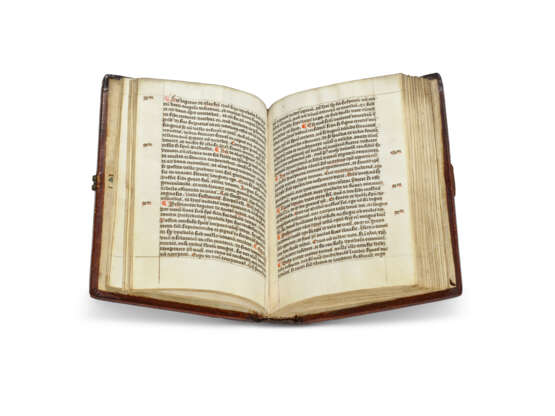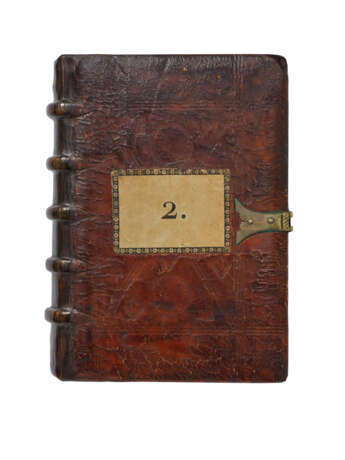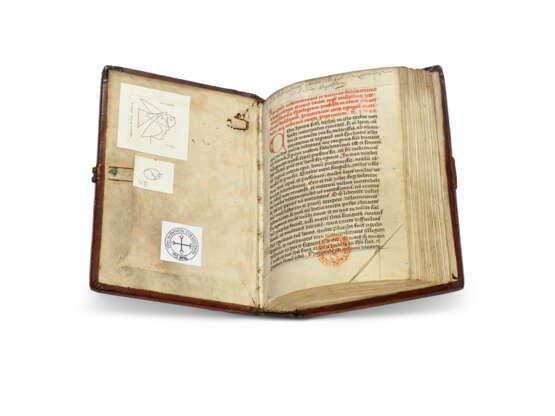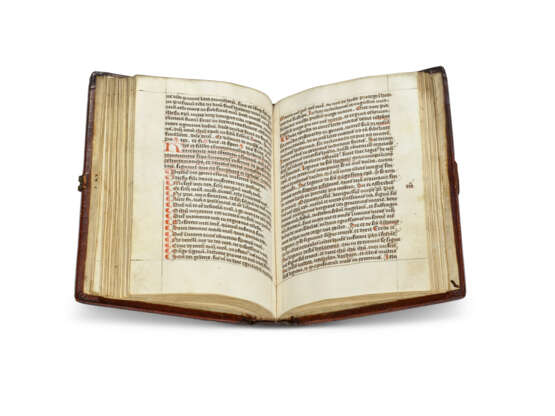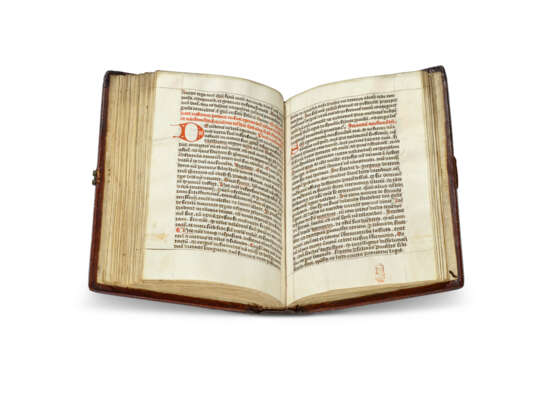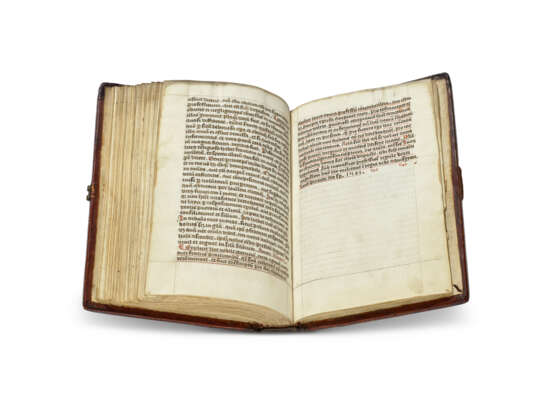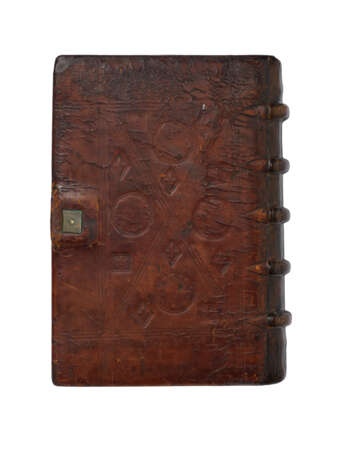ID 1214882
Лот 60 | A treatise for dying well
Оценочная стоимость
£ 15 000 – 20 000
Guillelmus Textoris / Wilhelm Zeewers (c.1425-1512), Preparamentum saluberrimum christiani hominis ad mortem se disponentis, in Latin, decorated manuscript on vellum, Aachen, 1501
A treatise for dying well, a rare manuscript copy from the author’s circle that predates the printed edition, with unique records of the Windesheim Priory in Aachen.
177 x 122 mm, 83 leaves: 16 (?of 8, lacking i-ii cancelled blanks), 2-108, 115 (?of 6, vi cancelled blank), unfoliated, text complete, 30 lines, ruled space: 137 x 90 mm, headings in red, text capitals touched red, authorities and numbered points underlined in red, paragraph marks, two- to five line initials in red, the larger patterned in reserve (lower corners of f.1 excised, slight marking along top edge of most pages).
Binding:
Contemporary binding of brown calf, blind stamped with tools of a large rose, a fleur-de-lis and an eagle within a central compartment framed and divided diagonally by triple fillets, spine in six compartments, metal catch on upper cover (rebacked, upper corners restored, lacking metal clasp, some wear to covers, paper label printed with 2 pasted on upper cover). Cloth box, title label gilt.
Provenance:
(1) Augustinian Canons Regular of the Priory of St John the Baptist, Aachen: copied by Brother Theoderic Clocker, for the present and future use of its members, 6 June 1501, as detailed in the colophon on f.80v-81, 'Explicit hoc nobile exercitium […] fuit transscriptum per fratrem theodoricum clocker huius domus professum conventualem […] gaudiose excopiavit hunc tractatum pro consolacione et informacione omnibus hanc domum inhabitantibus tam in presenti quam in futuro tempore […] annus post partum virginis […] millesimus quingentesimus primus die quinta mensis Junii in conventus domus sancti johannis baptiste ubi fratres canonici regulares sub monastica professione regule beatii Augustini domino deo militant in regia urbe aquisgrani […] 1501'; a further instruction that the book was to be kept by the infirmarian to help the sick and those preparing for death, with an account of the miraculous survival of Brother Wigboldus Gerardi de Daventria (Wigbold Gerrtisz of Deventer) when he fell from the roof of the new church on St Gorgon’s day, 9 September 1501, f.82v; record of the dedication of the new church, 9 November 1505, with a list of major benefactions, ff.82v-83.
The priory was founded c.1420 as part of the Neuss Congregation, which joined the Windesheim Congregation in 1429. Windesheim with its associated houses was the monastic equivalent of the Brethren of the Common Life, fostering the ideas of the devotio moderna, the movement that had a profound effect on spirituality and religious practice in the Netherlands and the Rhineland.
The manuscript remained with the canons – on f.1 is a 16th- or 17th-century ex libris: Ex bibliotheca Canon. Regul. Aquisgranensium ad S. Johannem Baptistam – presumably until their goods were sequestrated after the French occupation of 1794. Some of the priory’s manuscripts were preserved in Aachen; for them and the priory see J Greving, ‘Geschichte des Klosters der Windesheimer Chorherren zu Aachen’, Zeitschrift zur Aachener Geschichtsvereins, 13, 1891, pp.1-122.
(2) Paris, Bibliothèque nationale de France: red stamp of Bibliothèque nationale around RF on ff.1 and 83v; presumably coming to France as a result of the French occupation and sequestration; trace of black stamp at excised corner, f.1.
(3) H.P Kraus, New York: as part of an exchange with the Bibliothèque nationale, as confirmed by Roland Folter to The Schøyen Collection, see 6.
(4) Aachen, Ludwig Collection, Peter (1925-1996) and Irene (1927-2010) Ludwig, legendary art collectors and benefactors, purchased from Kraus: their book labels inside upper cover, with NE in pencil; Ludwig XI 11.
(5) Malibu and Los Angeles, J. Paul Getty museum, ms 83.MN.191; acquired with the Ludwig Collection in 1983 (The J. Paul Getty Museum Journal, 12, 1984, p.298); deaccessioned with other text manuscripts inappropriate to their collection. Sold by Bruce Ferrini, Akron Ohio, in January 2000 to:
(6) The Schøyen Collection, MS 2936.
Content:
Guillelmus Textoris, Wilhelm Zeewers, Tzewers, Preparamentum saluberrimum christiani hominis ad mortem se disponentis, ff.1-81: headed Incipiunt informationes et doctrine saluberrime quas collegit eximius doctor magister wilhelmus zceewers sacram theologiam professus in alma universitate basilinesi. practicande circa agoniam morituri. aut infirmum morti proximum, opening 'Cum homo secundum apostolum in isto exilio […]', f.1, and ending 'nobis omnibus prestare dignetur qui vivit et regnat in secula secularum. Amen. Amen', f.80v, colophon ff.80v-81; Ex obitu beati iheronimi, based on Eusebius’s account of St Jerome’s death (Patrologia latina, XXII, cap. XXXVI-XXXVII), ff.81v-82; instruction for the use of the book and account of Brother Wigbold’s miraculous survival, f.82; dedication of the new church and list of benefactions, ff.82v-83.
Preparing for death was preparing for eternal life. Dying in the right state of mind, through prayer and meditation as well as through the sacraments of the church, was critical. The responsibility of the individual to make himself worthy of Christ’s sacrifice, through which he could avoid damnation, was emphasised by the devotio moderna, with which the author was in sympathy.
Wilhelm Zeewers (Weaver, with many variant spellings), from Aachen, studied at the university of Erfurt 1446-1461 before moving to the new university of Basel where he became Doctor of Theology in 1462. He held a canonry at Basel cathedral and was an admired preacher; in 1484 he returned to Aachen where he was based until his death at an advanced age in 1512. In addition to his sermons, he was the author of an account of his pilgrimage to the Holy Land (see G. Hartmann, Wilhelm Tzewers: Itinerarius terre sancte. Einleitung, Edition, Kommentar und Übersetzung, 2004) and devotional works. For the manual for those approaching death he drew on the writings of St Anslem and Jean Gerson, especially his Opus tripartitum, as well as on the Ars moriendi blockbook to construct a work intended not only for the dying but for priests and infirmarians so that they could provide effective guidance. It was printed as Preparamentum saluberrimum christiani hominis ad mortem se disponentis in 1502 and in a Low German translation, Eyn seer vruchtbars boexken genant Mygrale, in 1503 and 1510 by Hermann Boengart at Cologne; an Upper German translation was made in Basel by the Carthusian Lucas Moser in 1501, when Zeewers was said to be 82 years old (Basel, Univeristätsbibliothek, ms A.X.117, ff.2-149v). See W. E. Fromm, ‘Beiträge zur Lebensgeschichte des Wilhelm Textoris von Aachen’, Zeitschrift zur Aachener Geschichtsvereins, 14, 1892, pp.243-262; F. Landmann, ‘Zur Geschichte der oberelsässischen Predigt in der Jugendzeit Geilers von Kayersberg. Der Basler Universitätsprofessor und Münsterprediger Wilhelm Textoris und sein Predigtbuch in der Stadtbibliothek zu Colmar’, Archives de l'Eglise d'Alsace. 1946, pp.133-161.
Latin manuscript copies of the Preparamentum seem extremely rare: there was previously a manuscript of the work, dated 1500 and with differently worded opening heading, in the Aachen Stadtbibliothek, ms 63; it was lost in World War II (A. Mentzel-Reuters, Die Handschriften der Stadtbibliothek Aachen, Katalog der mittelalterlichen Handschriften, 1994-213). It and the Schøyen copy appear to have been overlooked in scholarly discussion. They may well have had the same origin as there would be nothing unusual in the same house producing more than one copy of a work. The Windesheim Congregation was committed to the provision of suitable and accurate texts to aid the individual’s path to salvation; many canons were active as scribes and Theoderic Clocker could have been inspired to make his gift for the Priory by the copying of the slightly earlier manuscript. Clocker, a member of a leading Aachen family, had entered the community in 1464 , four years after his uncle, Heinrich Clocker, had ceased to be prior, and lived until 1531: he was the only canon to see both the start and the completion of their new church. At various times he held the offices of sacristan, subprior and procurator. Clocker undoubtedly knew Zeewers, who was a member of the Fraternity of the Canons Regular in Aachen: his death in 1512, and his generous donation, are recorded in the Fraternity book, with his name spelt Zceewers as in the Schøyen treatise. The text copied is likely to have been, literally, authoritative, since Clocker presumably used one approved by Zeewers, perhaps even an autograph, so that the Schøyen copy is an important witness to the text, predating the printed edition. Furthermore, the records Clocker added to the manuscript significantly supplement the community’s history and offer an intriguing insight into how he envisaged Zeewers work should be used.
| Место происхождения: | Западная Европа, Германия, Европа |
|---|---|
| Категория аукционного дома: | Манускрипты Средневековья и Ренессанса, Книги и рукописи |
| Место происхождения: | Западная Европа, Германия, Европа |
|---|---|
| Категория аукционного дома: | Манускрипты Средневековья и Ренессанса, Книги и рукописи |
| Адрес торгов |
CHRISTIE'S 8 King Street, St. James's SW1Y 6QT London Великобритания | |
|---|---|---|
| Предосмотр |
| |
| Телефон | +44 (0)20 7839 9060 | |
| Комиссия | see on Website | |
| Условия использования | Условия использования |
